Pines: Not just for breakfast anymore
Euell Gibbons became famous for asking, “have you ever eaten a pine tree?”
A lot of folks had a laugh over that, but perhaps Euell will have the last laugh. We all probably have an ancestor who ate a pine tree or part of it now and then. I know I did. And people may eat pine again. It’s a family with over 200 species and has served man well, famine food to ship masts. So much has been written about this family let me see if I can say a few things others haven’t.
Where ever there have been pines and people the people have depended on the pines. Besides food, they had and still have medical uses. Pines have been used for the making of stimulants, laxatives, diuretics and vermifuges, among many including Shikimic acid, the main crude ingredient in Tamiflu.
There are actually two groups of pines, softwood pines and hardwood pines. The soft pines have needles that are found in groups of five on twigs. Their wood is actually low in density. Hard pines have needles in groups of two or three per twig. Their wood is moderate in density. This may seem like a technical distraction but often telling pines apart is very difficult and how the needles arrange themselves is important… unless you are making pine needle tea, then just put a few needles or the tip of a young branch in hot water and you’ll have a nice serving of Vitamin C. Pine needle tea saved many a sailor in olden days from scurvy. (Despite what some websites say, in tea form the pine needles are no threat to pregnant women. In fact let me explain that.)
The basis for this rumor is a veterinary study decades ago. If you are a cow and you eat many pounds of Ponderosa Pine needles you have a 5 to 8 percent chance out of 100 of having an abortion or still-birth. If you boil a huge amount of pine needles in water for hours down to a small amount of gross liquid and you drink it, then maybe it would cause an abortion. A few of needles soaked in hot water is no threat to anyone except for possible allergies. Here’s what famous forager Euell Gibbons had to say: “When I was a boy we used to eat ponderosa pine for pleasure . . . called it “slivers”. In the spring the bark is really gorged with starches and sugars and tastes quite sweet. It’s also high in vitamins.”
The cambium of the pine (between the bark and the wood) can be boiled or roasted as a famine food, and makes a reasonable flour. Fried in olive or coconut oil it’s actually tasty. The cambium near the base of the tree is better than the cambium near the top of the tree. That bit of advice always struck me as odd as if I would climb a pine to get a strip of bark off the top when the bottom is so close and handy. And of course nearly everyone has had a pine nut or two. Animals like the pine nuts as well, including squirrels, turkey, quail, and brown-headed nuthatches.
The collecting of pine nuts for human use is a debatable issue. Some 20 species of pine have nuts big enough to harvest for human food. If foraging is a hobby, then go ahead and collect a few (put the brown, unopened female cones near a fire to make them open and release the seeds.) If in a survival situation, however, one could expend more energy collecting pine nuts than energy gotten from the pine nuts so it is a significant decision to make when out of food. Female pine cones can weigh up to 10 pounds and be two feet long. The pinyon pine, where we get the familiar pine nut in the US, is the only pine with one needle per twig.
But, there is more to the pine than nuts, cambium, and needles. Like the cambium, the young male pine cones can be boiled and eaten. What is a male pine cone? Well, they are small, soft and papery whereas the female cones are woody and tough. Male cones really shouldn’t be called cones. Technically they are microsporangiate strobili. Say that at a cocktail party and see how many conversations you start. (Hint: micro-spore-WREN-gee-ate stro-BYE-lee) The best I can do is that a male pine “cone” looks like a small cluster of toasted coconut bits shaped like orzo. See picture, upper right. If you have a better description let me know.
Here is another little known fact: During certain times of the year my pickup is covered with a light yellow dusting. Starting in winter here and going into spring the pines have sex on their minds and the fellows are releasing pollen. For some pine pollen means misery from sniffling and sneezing. But pine pollen is more than just the mere powder of pine lust.
Pine pollen is a large particle, and since it depends on the wind, it can’t travel too far. It also has a waxy coating on it’s surface which makes it a minor allergy trigger, though a few folks are allergic to it. When the pine is pollinating other trees that are more significant allergens are secretly pollenating such as birch, cedar, oak and sycamore. Often folks who think they have a pine allergy are actually allergic to one or more of those other trees.
Which brings me back to pine pollen. It has over 200 identified elements from vitamins to proto male hormones… yeah, it’s a guy food. It’s been called the natural testosterone, androstenedione, but that is a marketing exaggeration. It has about 27 nanograms per 0.1 grams of dry weight, not suitable for the bulking up weightlifters want, but available none the less. Putting the pollen under the tongue keeps it from being destroyed by the digestive system.
Androstenedione is an adrenal hormone produced in humans. Reduce androstenedione by one molecule and you have testosterone, which both men and women have in different amounts. Androstenedione can raise testosterone levels. The effect lasts about a day. And this is how the Native Americans used it, for extra energy when they needed it. So when on the run, grab a little pine pollen. Pine pollen also seems to have a beneficial effect on the cardiovascular system as well. How do you collect it? Put a sack over the microsporangiate strobili and shake, if it is the right time of the year, lick the hood of your car.
And what about shikimic acid and the flu? Processed shikimic acid prevents the flu from reproducing, thus reducing symptoms and the duration of the flu. The drug Tamiflu is made from the seed pods of the Chinese star anise tree which is 7% shikemic acid. Researchers have found that White Pine needles have enough shikimic acid, 3%, to make its extraction commercially viable. Spruce also have the acid and it is presumed other pines do in varying amounts.
The English name pine comes from the Greek Pitus thru Latin Pinus (PIE-nus and PEE-nus) by way of French “pin.” Contemporary Greeks say ;’ PEF-ko.” That takes us now to how the Greeks use pine, and that is to flavor a white wine called retsina.
Greeks have been making retsina for a few thousand years. It was an acquired tasted by accident. They stored their white wine in clay containers lined with pine pitch (to keep them from weeping.) The wine took on the subtle flavor of the pitch. Now days, retsina comes in a wide range of flavors, from delicate to intense. I have several relatives who make it. One of my fondest memories of Greece was having cloudy, young, homemade retsina high in the mountains after a meal of kid roasted on an olive wood fire. There’s one other advantage to retsina: Take it to a party and no one will steal your wine. To make your own retsina the short way, put a pea-size piece of pine pitch in a bottle of cheap chablis and let set in the refrigerator for a long time.
Young pine roots are edible as are stripped pieces of their bark. The bark can be seeped in water for its sugar and the water drank. Also, many pine trees have burls on a limb and those can be broken off and used as a throwing stick or mallets.
NOTE: The “Australian Pine” is NOT a pine. It can not be used like true pines.
Green Deane’s “Itemized” Plant Profile
IDENTIFICATION: Pines are evergreen and resinous trees growing to 100 feet tall, the adult tree has long needles in clusters of three to five up to 18 inches long.
TIME OF YEAR: Needles and inner bark available year round, young male cones and pollen in spring.
ENVIRONMENT: Pines grow well in acid soils, some on calcareous soils; most require good drainage, preferring sandy soils to accommodate a large tap root up to 12 feet.
METHOD OF PREPARATION: Needles raw as a nibble or in hot water for tea, or chopped and used like rosemary. Inner bark near base is edible, preferably cooked, can be made into a flour, very high in vitamins A and C, young male cones boiled, pollen eaten as is. The core of young roots are edible raw when peeled of the outer bark. The young root bark can be seeped for its sugar content.
HERB BLURB
Icelanders of the 1400’s took pine sap mixed with honey to ease lung troubles. Oriental herbalists use pine knots as medicine, especially for arthritis.
Spatchcocked Chicken
Traditionally a spatchcock is a game bird that is prepared for roasting, broiling or grilling by removing the backbone and sternum of the bird and flattening it out before cooking. In this recipe the pine needles are used like rosemary.
3 ½ – 4 pound young chicken,
Sea salt and ground pepper
2 tablespoons young pine needles or shoots, minced
2 -3 tablespoons lime juice
Rinse chicken with cold water, dry. Remove extra fat, trim off wing
tips. Place chicken breast side down and using poultry shears cut along
backbone, starting at the neck. Repeat on the other side of the backbone
Spread the two sides apart and press down on the breast so that the chicken
lies flat. Season both sides with salt and pepper and lemon juice.
Build a charcoal fire on one side of your grill;. Place chicken skin side down at the edge of the fire with legs closest. Turn over when skin starts to brown. Turn and move chicken to the side of the fire and cover with a large disposable aluminum pan. This creates a “mini” oven providing high heat off the direct fire. The grill cover can be used, but the browning and flavor will be less. Cooking time varies, depending on the fire and the size of the chicken. Check the temperature at 20 minutes after turning. When the temperature in the thigh reaches 175 degrees, remove from the heat and let sit, sprinkle with chopped pine needles, loosely covered for 15 minutes before carving.
Pine Needle Tea
You can make pine needle tea two ways. One is to pull three or four needles off a tree and stick them in a cup of hot water. Wait a few minutes then enjoy with or without sweetener.
Or collected a handful of pine needles. Needles nearest the trunk are higher in Vitamin C. Chop the needles and put them into a tea ball. Bring water to a boil. Take off the boil. Steep the pine needles for 3-5 minutes. The tea is delicate.
Pine Infused Vinegar By Pascal Bauder
Pine infused vinegar: Apple cider vinegar and pine needles were placed in a jar for 6 weeks after water bath canning. The ratio is around 50% pine needle and 50% vinegar. Extremely sharp (pine needles have this lemony/tart flavor) so I also added some of my pine sugar (pine needles powdered with organic sugar) to it. It’s delicious, sort of sweet and sour with a pine touch. It was quite cloudy so had to filter it twice. Soon in a couple of restaurants in Los Angeles. For the vinegar infusion I used fresh needles and for the pine sugar I used dehydrated ones. So it’s a mix really. Just apple cider vinegar and pine was quite…sharp which is why I added the sugar.

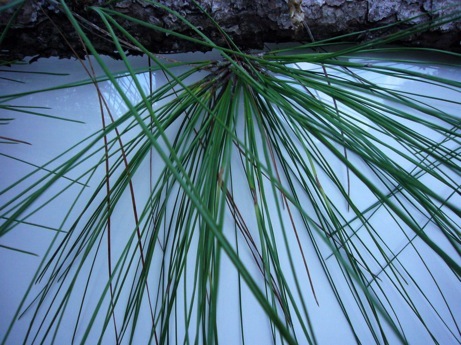
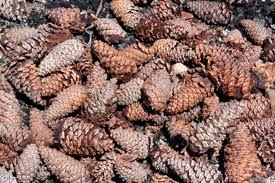
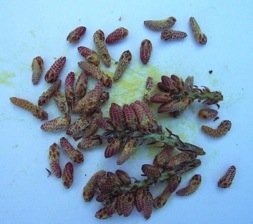
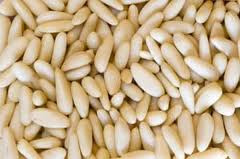
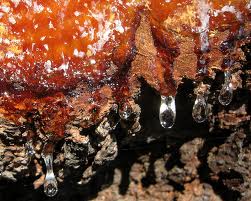
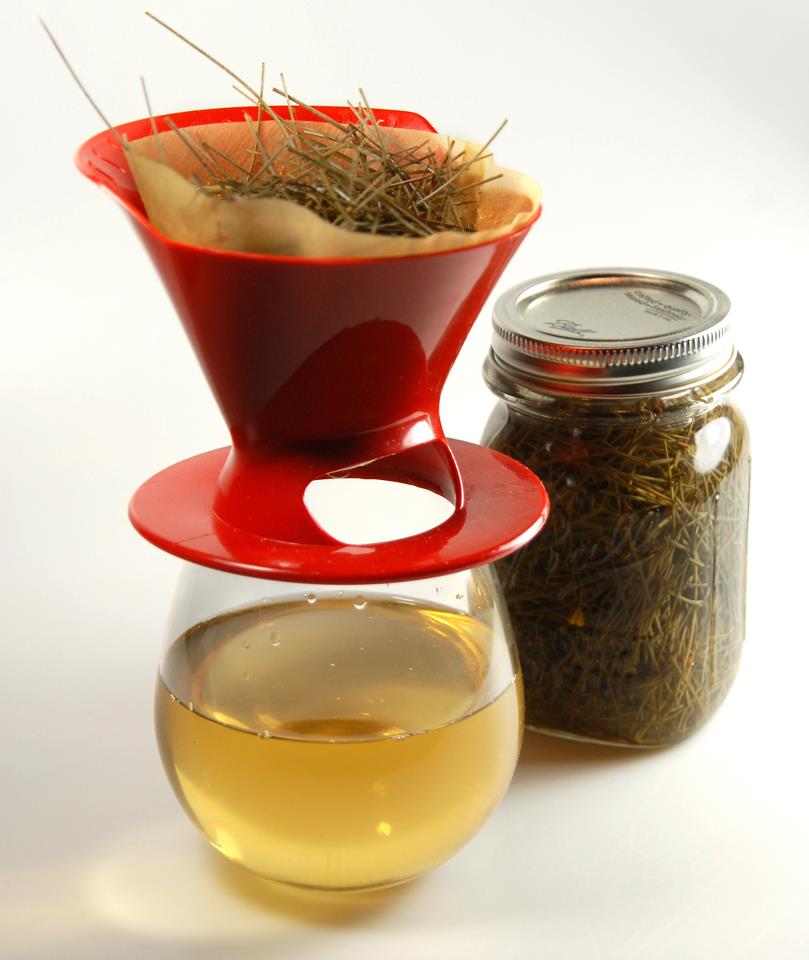

[quote]Needles raw as a nibble[/quote]
No thanks. I tried that. lol Considering the straight needle juice (undiluted) can be used as a cleaner (I assume like citrus juice cleaner), I can understand why. I read one source that says the needle juice “may” work for an insect repellent. The only reason I can think is the strong odor. I have not really tried it. I doubt just rubbing the needles in the hands would do, but maybe. Probably need to crush the needles to extract the juice. Juice extraction (getting enough to put on the skin) is the main reason I have not tried it. The other reason is the stickiness of the juice.
Indigenous folks in the Pacific NW made incense cedar balm for healing skin, mistening lips, and insect repellent. I’ve made several kinds of cedar balm & keep it on hand. Natives used beeswax, but since I’m vegan I use carnuba. Infuse needles just under a boil for about 6 hours in oil (I use olive), strain with cheese cloth, then add carnuba to get consistency.
Young, tender, bright green tips of pine branches are actually edible as a strong-tasting salad green, but they have to be very young and almost feathery-soft, well before they get resinous, otherwise you may as well chew on mature needles.
I’ve heard that in some northern areas, it used to be an important source of food in the late winter and early spring, being readily available before most edible vegetables had a chance to grow. Other conifers are similarly edible, like spruce and fir. Luke
Well I enjoy in the information and I wonder what about the norfolk pine it no pine cone as I know of.
Rather it flake of it`s seeds and can they be eaten?
Norfolk pines, if I remember correctly, are not pines but Araucarias.
Does harvesting the cambium hurt the tree?
It depends on how you harvest it. A longitudinal strip is okay but a circular one kills the tree. Better, get it from trees that have been cut down, or blown down.
I enjoy your articles. You are quite funny. Nice to learn something scientific and enjoy learning it.
Hello Dean.. I’ve read this recently and would like your opinion: “Pine, Fir, or Spruce? – Look for the number of needles that come out of the same spot on a twig. If a twig bears needles in groups of two, three, or five, you can safely call it a pine. If the twig carries its needles singly, it’s a good bet you’ve got a fir or a spruce. Pull off a needle, and roll it between your fingers. If it feels flat and doesn’t roll easily, it’s a fir. If the needle has four sides and, thus, rolls easily between your fingers, it’s a spruce.” … now from reading your article, I know that the pinyon pine is an exception because it is a pine and has one needle per twig. Any quick tips or warnings about getting the varieties mixed-up? Thanks as always!
All sounds good to me. However, avoid cedars. To much of the oil is not good.
“Too much of the cedar oil is not good”. In what way? There are “ringing” cedar trees in Siberia, 500 year old trees, where the oil is prized for its healing properties. Perhaps it is because of their age that the oil is more medicinal?
I just started getting your new letter. Amazing, detailed information; thank you. I appreciate your direct approach and not adding all the fluff that typical websites include…like why you should like a plant or pharmaceutical “warnings” (that are to keep drug companies in business), etc.
As the site is about edibles consuming too much cedar oil is not good.
It is a language barrier, the ringing cedars of Russia, it actually is a pine. And the oil is made of pine nuts and some is from resin also. Check out their website, or do a bit more research.
Readers may want to note that pine trees in city parks have probably been sprayed, and that no part of the tree will therefore be chemical-free.
Sprayed with what and why?
Our local park sprays them for mountain pine beetle. The only spots where they don’t spray is next to a waterway.
They are not sprayed here.
hey dean i stumbled across some pine sugar, i was trying to make pine oil with a small distillery i made, then i boiled the pine rich fat wood that i recovered from a long dead pine and recovered the pine knots. when i emptied the can i was boiling in, the sugar was attached to the sides of the can. after scraping off the sides of the can, i had a spoon full of brown pine sugar.
thanks dean.
..bill
I enjoy the taste of cold “pine needle water”, better than the hot tea method. I put about a teaspoon of cut needles in a blender with a cup of cold filtered water, blend about 6 seconds (until the water turns slightly green), then sieve out the needles, and drink. But I’m not sure that it is the best way to get the vitamin C, or does steeping them in hot water offer more benefits?
Thanks for this. I like to hear of raw options for wild plants. :))
Actually, considering how easily Vitamin C is destroyed by heat I think cold beverages would be the best way to get it.
A study reported by the NCBI showed that the hot water extract possessed superior antioxidant activity over other methods.
http://www.ncbi.nlm.nih.gov/pmc/articles/PMC3180677/
If you are boiling your needles the end result is supposedly pretty nasty. Dr. Mark Vorderbruggen writes that this is because boiling the needles releases a high concentration of unpleasent turpenes.
I bring my water to a boil, wait for it to settle back down, and then pour the hot water over the needles and let it steep until they sink to the bottom, and my tea tastes just fine.
If you take some of the sap brown in color not the Sticky stuff but mature sap and chew on it the sap makes great sugar free gum wait until the powdery bitterness goes away and gum forms.
When I was young in the South, during the summer month.s We had a sock tied with a knot full of pine pollen. If we were going to play outside during dusk when the mosquitos came out. We would hit our arms,legs, and neck with the sock and rub the yellow pollen all over our skin. It keeped them away. I have no idea where the adults got that much pollen. But I have been know as a adult to run my hand across the hood to collect pollen for the same use.
Are there any tools you recommend be used for harvesting cambium from felled trees? An axe? A saw? A knife? A spoon??? I can’t find any “how-to” information for this.
Yes… once you are down to the cambium a pull type cucumber peeler works well.
With the pine needle vinegar use a plastic lid (can be recycled from mayonnaise jar) instead of the metal lid. See if that helps. 🙂
I live in an Alaskan monoculture of sitka spruce. I’m interested in the nutritional qualities of spruce pollen. All of my web searches for spruce pollen bring up pine info and I’m curious of the differences between the two.
I was born and raised in Flagstaff, Arizona. I have never known you can eat pine until now! Though I am a tad skeptical because we have the Ponderosa Pine out here; which I hear is toxic.
That having been said. As a child, I used to always call the male pine cones “Tree Shrimp” because they reminded me of my favorite food at the time, shrimp. That could be one way to describe them.
Thanks, Green Deane, for another informative article. I am confused, however, about the ideal needles to use:
“…just put a few needles or the tip of a young branch in hot water and you’ll have a nice serving of Vitamin C.”
“Needles nearest the trunk are higher in Vitamin C.”
I’ve been confused by this before, some people saying that the branches nearest the sun on the east side are higher in vitamins, others saying that the lower, shaded needles have the most vitamin C. Can you clarify this, and give the source for your information?
Well, I don’t know about east or the sun but… Vitamin is a chemical that is destroyed by sunlight, heat, and age. Young needles, and younger parts of the needles haven’t had their Vitain C degraded as much as older needles and older parts of needles.
Read more on the flavors of the pine. foodpairing analysed the douglas fir. This one has piney, woody aromas but also citrus aromas are very present. Pine pairs well with asparagus, gin, lemon, kaffir, carrots and more. Blog.foodpairing.com
I just pickled some pine and spruce tips last week and I love the way the pickling actually takes away the pitchy texture that is unpleasant and turns them more chewey! I just got a dehydrator too so im excited to make some pine sugar!
Is pine needle juice safe do you think? I’m surrounded with pine needles, and I have a juicer made for juicing greens; so it makes practical sense.
Would you “juice” a bay leaf? Usually pine needles are not eaten. usually things that go into a juicer are things one would eat.
Dan, Every spring, when the needles shoot out a lighter green growth of new needles, I collect. I rinse, cut off those tender tips, and after pulling off lower needles, strip the bark with blade of knife, discarding that wood center. Throw all into Ninja, with a bit of water, then pour into bowl lined with clean white T-shirt material. I squeeze out as tight as I can, all liquid. Pour into little tiny stackable containers (get at Job lot) to freeze. Daily, I defrost one in the evening, and pour into large cup making a tea. The color is green when freezing, yet pulp and liquid will separate when frozen. I drink to almost bottom, and throw away the sediment. You can add a bit Agave, Honey, or drink as is. Very, very healthy drink. Loving it. ???
Confused. “Pine infused vinegar: Apple cider vinegar and pine needles were placed in a jar for 6 weeks after water bath canning.” So how does one add acv & pine needles after water bath canning (what?)? Do you mean to ferment for 6 weeks, then water bath?
In your video on pine nuts you show a measuring cup full of very tiny pine nuts (next to the regular pine nuts). I’m thinking that it might be interesting to use the tiny nuts in baking. How did you collect the very tiny pine nuts? Thanks! Love your videos! Kevin
It’s really difficult…
To (relatively) easily get them out of a cone it’s pretty easy. Once you get a bunch of cones with the seeds ready to be released, put them all in a bag and let them sit in a very warm place (maybe a greenhouse) and after a few days they’ll pop open and fling their seeds everywhere (hence the bag to keep them contained). Remove the cones and you’ve got the nuts.
Unfortunately, there’s also a shell surrounding each nut which some people find unpleasant to eat, so if you’re wanting to expedite that process, I got nothing for ya.
Taking Pine Pollen for breakfast will give you a burst of sporadic energy throughout the day
Its great stuff..
Cheers
I have been wanting to try pine needle tea and was so disappointed as I could only find Ponderosa in my area and read it was no good.
I’m glad I stumbled on this page and know that’s more of a myth. I’m excited to try bark flour as well!
Hi, I have just gotten some white pine needles and have made wonderful tea, but am wondering how long I can use the needles. They are starting to turn brown (just a little) and wasn’t sure if that meant they weren’t giving me the nutrients anymore. I saw somewhere that I could freeze them. What is the best way to store for short periods and how long are they good for? Thank you so much for any information as it is hard to find in depth knowledge.
You can use them while they are green.
Great info once more Green Deane! thank you! about the male pine cones, you said that they have to be boiled, is there a problem if you eat them raw? I am asking because I have tried many times raw male cones of Pinus halepensis when they are still young and green a little before they become full of pollen and actually they have a kind of sweet taste. Is there any danger of eating them raw? Thank you
Young female cones are boiled, you can eat the male cones raw but they are rather dry-sponge like.
Hello! I’m dying to make use (preferably in tea!) of the piles of pine needles that fell to the ground in my backyard. I did some app scanning for identification, and it says loblolly pine. A quick google search gives that i should avoid lonlolly pine for tea since it’s toxic, while some others on the internet say all evergreens can safely be consumed. I live in georgia and it’s 3-needle bunch long leaf pine. Do you think it’d be safe to make tea out of it?
Actually on my site “needles” is spelled correctly.